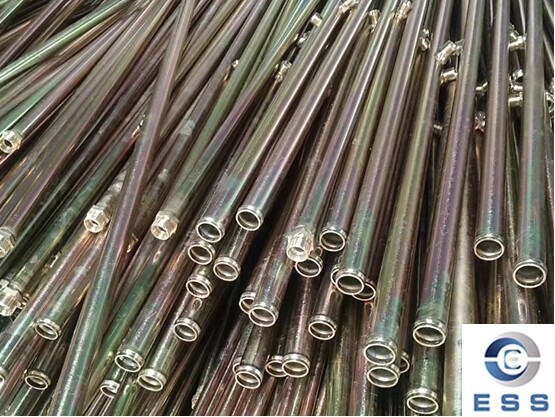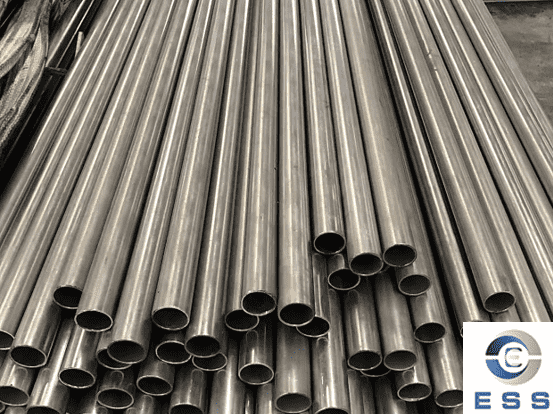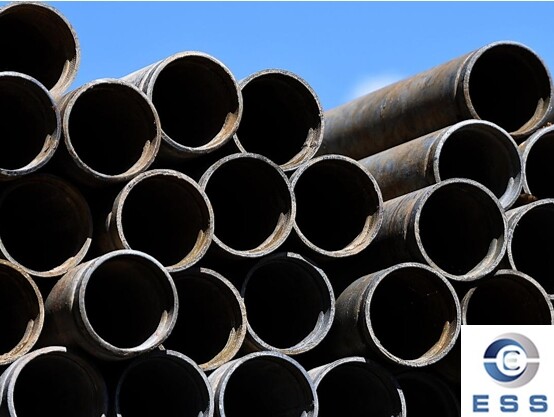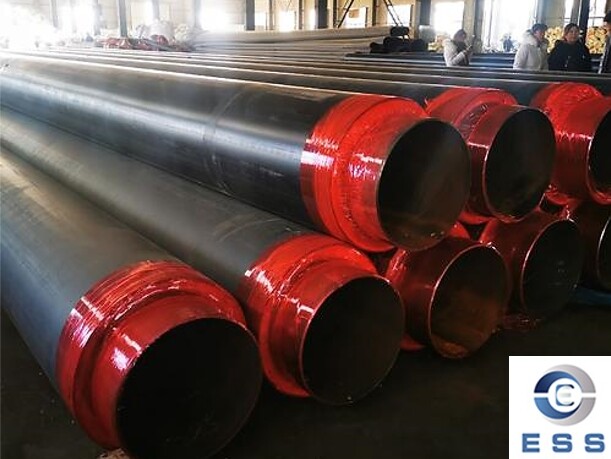
Hard hydraulic
tubes are an important part of the hydraulic system, used to transmit the
pressure of hydraulic oil and transport various media. Hard hydraulic tubes are
usually made of metal materials such as steel, copper, and aluminum, and have
strong rigidity and pressure resistance.
Hard hydraulic tubes are generally composed
of pipe bodies, joints, and crimping joints: the pipe body is usually made of
high-strength steel and the interior is smooth to reduce pressure loss; the
joint is usually made of copper alloy or stainless steel to connect the pipe
body and hydraulic components; the crimping joint is used to fix the pipe to
the hydraulic component.
There are many connecting hard pipes used
in hydraulic systems. Once these pipes are damaged and leak oil, they will
pollute the environment, affect the normal function of the system, and endanger
safety. The selection, processing, and installation of hard hydraulic tubes are
a very important part of the transformation of hydraulic equipment. Mastering
the correct method will help the stable operation of the hydraulic system. How
do we choose the right hard hydraulic tube?
Material selection
The determination of hard hydraulic tube
materials depends on the specific application and should be selected according
to the system pressure, flow and operating conditions:
1. Steel pipe
Medium and high pressure system piping
generally uses seamless steel pipes. Due to its high strength, low price, and
easy to achieve leak-free connection, it is widely used in hydraulic systems.
Ordinary hydraulic systems often use
cold-drawn low-carbon steel 10, 15, and 20 seamless
pipe. This steel grade can be reliably welded with various standard pipe fittings when piping.
Hydraulic servo systems often use ordinary stainless
steel pipes, which are corrosion-resistant, have smooth inner and outer
surfaces, and precise dimensions, but are more expensive.
2. Copper pipe
Can withstand high pressure, low price, oil
resistance, corrosion resistance, good rigidity, but cannot be bent arbitrarily
during assembly. It is often used as a pressure pipe in a place where it is
convenient to install and disassemble.
3. Red copper pipe
Easy to bend into various shapes, but the
pressure bearing pressure generally does not exceed 6.5-10MPa. It has a
relatively rigid vibration resistance and is easy to oxidize the oil. It is
usually used in places where it is inconvenient to connect in hydraulic
devices.
Size selection
The two key dimensions of hard hydraulic
tubes are outer diameter and wall thickness:
1. Inner diameter
The flow rate and flow velocity of the
fluid in the hydraulic system are mainly determined by the inner diameter of
the hard hydraulic tube. The inner diameter of the hard hydraulic tube is equal
to the outer diameter of the hard pipe - 2x wall thickness. The unit of flow
represents the amount of fluid that flows through the hard pipe line to
complete the task within a specific time. The unit of flow velocity represents
the speed at which the fluid flows through the hard pipe line. As the inner
diameter of the hydraulic tube decreases, the flow velocity increases.
Pipeline inner diameter calculation
formula: d=√(Q*K)/V
Where:
Q, flow rate per minute (L/min)
K=21.2025 (constant)
V=flow velocity (m/s)
d=oil pipe inner diameter (mm)
2. Wall thickness
The working pressure, design coefficient,
and hard pipe material of the hydraulic system jointly determine the wall
thickness of the hydraulic tube. The design coefficient considered when the
system working pressure determines the wall thickness is 4:1, mainly
considering other mechanical and hydraulic stresses that may act on the
hydraulic tube when the system is working.
The standard practice in the industry is to
use a design factor of 4:1 for hydraulic system design, refer to SAE J1065 and
ISO 10763, and obtain the nominal reference working pressure of various steel
pipe sizes.
3. Length
Cut or order the appropriate length of hard
hydraulic tube according to actual needs. If the length of the hard hydraulic
tube is not qualified, some problems will occur during use. If it is too long,
it will be difficult to assemble it to the specified position, and if it is too
short, it will be difficult to use it normally. Therefore, the length tolerance
is usually set according to application requirements and customer needs,
generally within plus or minus 1mm.
4. Fluid flow rate
When selecting the size of the hydraulic
system hard pipe, the fluid flow rate is a major consideration. In the pressure
line, higher flow rates can cause more heat generation, severe turbulence, and
pressure drop. In the suction line, high flow rate fluid may cause pump
cavitation.
The following maximum flow rates can be
used as the initial limit values for hydraulic system design:
Pressure line: 16 ft/s
Return line: 10 ft/s
Suction line: 4 ft/s
Pressure selection
There are usually three pressure standards
for hydraulic tubes: allowable working pressure, bursting pressure and
explosion pressure:
1. Allowable working pressure
The maximum pressure that the hydraulic
tube can withstand under normal use;
2. Bursting pressure
The minimum pressure at which the hydraulic
tube may burst under abnormal use;
3. Bursting pressure
The pressure at which the hydraulic tube
may explode after exceeding its maximum allowable pressure.
The maximum pressure of hard hydraulic
tubes can reach more than 5000 PSI, and many manufacturers' hard hydraulic
tubes will be additionally reinforced and tested to ensure that they can
withstand higher pressures. In general, the bursting pressure of a hard
hydraulic tube is about 4 times the pressure it withstands. When using a hard
hydraulic tube, you should pay attention to the maximum pressure it withstands
to avoid rupture under high pressure.
Bending radius
The bending radius of a hard hydraulic tube
directly affects the mechanical properties and service life of the pipe. The
bending radius standard is generally determined based on the diameter of the
pipe.
Note the bending radius of a hard hydraulic
tube:
1. Avoid bending radius less than the
standard value
In order to maintain the performance and
service life of the hydraulic tube, the bending radius should be avoided to be
less than the standard value, while keeping the shape after bending not easy to
deform. Generally, for hard pipes with a diameter less than 20mm, the bending
radius is not less than 4 times the diameter of the pipe; for hard pipes with a
diameter ≥20mm, the bending radius is not less than 5
times the diameter of the pipe.
2. Bending radius adjustment
For some special hydraulic systems with
high requirements, the bending radius may need to be adjusted according to the
specific situation, but it should meet the safety and durability requirements
of the system.
3. Bending direction
The bending direction of the hydraulic oil
pipe should avoid friction with the fixed position of the pipe or shear force
after bending, otherwise it will cut the pipe or damage the internal oil seal
of the pipe.
Connection method
Choose a reliable connection method, such
as welding, flaring, ferrule, etc., to ensure the sealing and reliability of
the pipeline.
1. Threaded connection
It is a common hard hydraulic tubeline
connection method, usually used in low-pressure systems and small-size
pipelines.
Vertical threaded connection (imperial
thread connection): This connection is usually used for imperial pipelines,
including thread types such as NPT, NPTF, PT, BSPT.
Flat sealing threaded connection (metric
thread connection): This connection is usually used for metric pipelines,
including thread types such as M, G, R, Rp.
2. Flange connection
Prevent leakage through the gasket seal
between the two flanges, often used for the connection of high-pressure hard
hydraulic tubes.
Welded flange connection: This connection
is often used for large pipelines and high-pressure pipelines.
Bolted flange connection: This connection
is often used for small and medium-sized pipelines.
3. Plug-in connection
The quick plug-in device can be used to
quickly remove and install the pipeline without tightening the threads, making
it easy to disassemble. Common plug-in connections include:
Double-cylinder connection: This connection
is formed by the cooperation of two cylinders, so it is also called cylinder
column connection.
Ring groove connection: This connection can
make the pipeline obtain good support and sealing when plugging and unplugging.
Summary
In short, when choosing hard hydraulic
tubes, we need to comprehensively consider key factors such as materials, size,
pressure, bending radius and connection method to ensure safe and efficient
operation of the system.













 Eastern Steel Manufacturing Co.,Ltd not only improve product production and sales services, but also provide additional value-added services. As long as you need, we can complete your specific needs together.
Eastern Steel Manufacturing Co.,Ltd not only improve product production and sales services, but also provide additional value-added services. As long as you need, we can complete your specific needs together.










